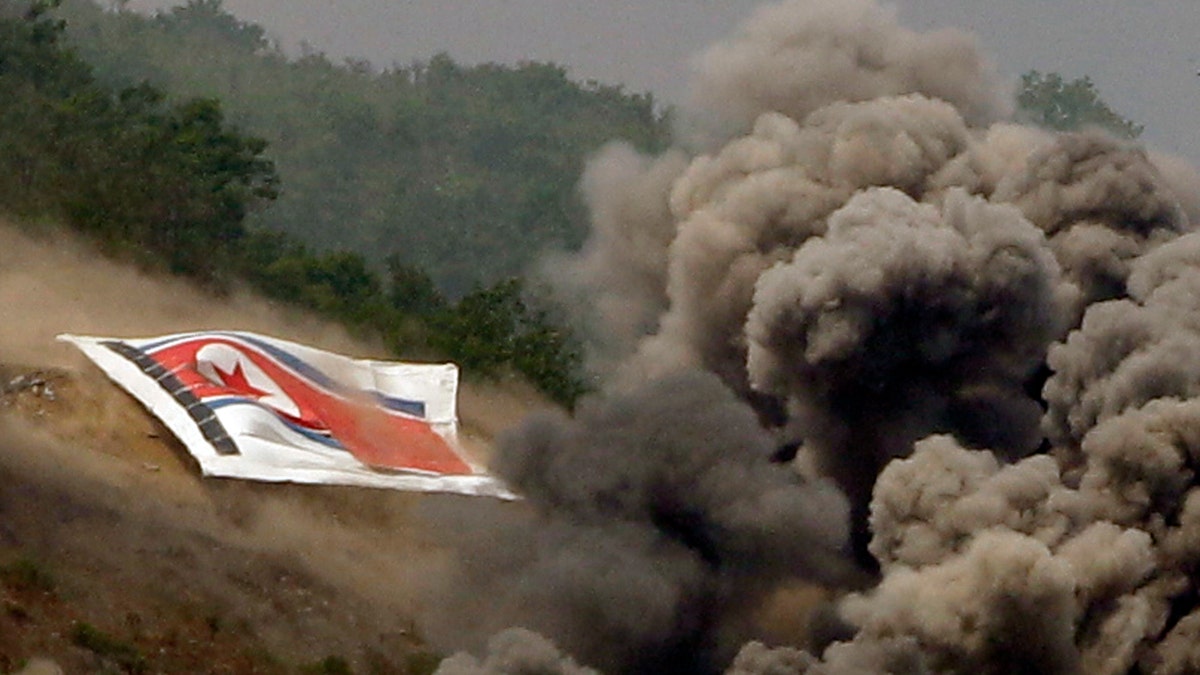
June 19, 2012: In this photo, smoke rises from explosions near the North Korean flag during South Korea-U.S. joint military live-fire drills at Seungjin Fire Training Field in Pocheon, South Korea, near the border with North Korea.
POCHEON, South Korea – A huge North Korean flag disappeared behind a tower of flames and thick black smoke Friday as South Korean fighter jets and U.S. attack helicopters fired rockets in the allies' biggest joint live-fire drills since the Korean War.
The war games south of the heavily armed Korean border come amid rising animosity between the rival Koreas and are meant to mark Monday's 62nd anniversary of the start of the 1950-53 war, which ended in a truce, leaving the Korean Peninsula still technically at war.
Live-fire drills by the allies are fairly routine, but using the North's national flag as part of target practice is unusual -- and will be seen as a provocation by Pyongyang, which has previously threatened war for what it called South Korean insults to the country's national symbols and leadership.
Still, an immediate North Korean military retaliation is unlikely. The rockets didn't hit the flag, which an analyst said might lead to a less angry North Korean response. But even a direct attack on the flag would probably only result in escalated North Korean threats because Pyongyang's struggling economy prevents it from staging any attack that could cause a war, said Koh Yu-hwan, a North Korea professor at Seoul's Dongguk University.
The one-day drills, involving 2,000 troops from both countries, are intended to send a clear warning against North Korea aggression by showing U.S. and South Korean combat readiness, South Korea's Defense Ministry said in a statement. Officials have described these as the biggest ever joint drills. They coincide with several days of joint naval exercises involving a nuclear-powered U.S. supercarrier and separate U.S., South Korean and Japanese naval rescue drills.
A U.S. military spokeswoman, Jennifer Buschick, wouldn't comment on the flag, deferring to the South Korean military. A South Korean defense official, who declined to be named because of office policy, said the flag was meant to mark enemy territory during the drills, but he wouldn't comment on Pyongyang's possible reaction to use of the North Korean flag in the drills.
North Korea's state media have condemned the ongoing drills as a precursor to an invasion, with the Korean Central News Agency warning that even a small clash could lead to a "full-scale regional nuclear war."
On Friday, the North's National Peace committee of Korea said in a statement that the drills are "reckless" and push the Korean Peninsula and the region "to the brink of a war."
Tension has been rising since a North Korean rocket launch in April that Seoul and Washington called a cover for a test of banned long-range missile technology. North Korea said the launch, which happened during celebrations of the centennial of late national founder Kim Il Sung's birth, was meant to send a satellite into orbit; the rocket broke apart shortly after liftoff.
The U.N. Security Council condemned the launch, and Pyongyang has since made a series of threats against Seoul's conservative government and media, vowing to attack unless it got an apology for perceived insults against the country and its new, young leader, Kim Jong Un.
Thousands of civilians and officials -- including South Korea's prime minister -- watched Friday's drills. The United States, which has 28,500 troops stationed in South Korea as a deterrent against North Korea, deployed Apache helicopters, A-10 Thunderbolts and armored vehicles for the drills, Seoul's Defense Ministry said in a statement.
Kim Jong Un took power as supreme leader of North Korea and its 1.2 million troops after his father, longtime ruler Kim Jong Il, died in December.
North Korea has condemned what it calls Seoul's insensitivity to Kim Jong Il's death and South Korean media criticism of important national events in the North. In recent months, North Korea has ramped up harsh rhetoric against South Korean President Lee Myung-bak, who ended Seoul's no-strings-attached aid to Pyongyang after he took office in 2008, with posters and slogans that repeatedly call Lee a "rat."
North Korea has also "drastically" increased fighter jet drills near the border with South Korea in the first half of this year, a South Korean Defense Ministry official said, declining to be named because of office rules. The official wouldn't provide further details.
On Thursday, the navies of the United States, South Korea and Japan began two-day annual search and rescue exercises near the southern South Korean island of Jeju. Starting Saturday, the United States and South Korea planned three-day naval exercises off South Korea's west coast that include the aircraft supercarrier USS George Washington.
